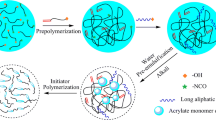Abstract
The waterborne fluorinated polyurethane–acrylate hybrid emulsion (WFPUA) was prepared by two steps, including the preparation of the fluorinated alcohol blocked polyurethanes (FBPU) in the mixtures of vinyl monomers and fluorinated monomers and then the free radical polymerization after the pre-emulsification of the said system. The effects of hydrophilic monomer (MDEA) on the surfactivity and the emulsifiability of the FBPU were firstly reported. Then, the particle size (d), zeta potential (ζ), and viscosity (η) of the WFPUA hybrid emulsion were characterized, respectively. At the same time, the surface properties and the mechanical properties of the films were investigated. The results show that the increase of MDEA is good for the emulsifiability and the lower surface tension of the FBPU. This increase improves the stability, the ζ and η, yet decreases the d of the WFPUA emulsion. However, it has disadvantages to the hydrophobic performance of the WFPUA films. When the content of the MDEA in the WFPUA is increased from 4.67 to 14.89 %, the surface free energies are increased from 22.22 to 27.28 mJ m−2 and the attenuation rate of the contact angle–time curve is increased from 0.3051° to 0.6290°/min. Also, with the increase of MDEA, the tensile strength and the shore hardness of the film are increased, but its elongation at break is decreased. The storage moduli of the film are enhanced remarkably. Meanwhile, the glass transition temperature of the soft segment [Tg(s)] is reduced and that of the hard segment [Tg(h)] is raised.






Similar content being viewed by others
References
Xu HP, Yang DY, Guo Q, Wang YY, W WL, Qiu FX (2012) Waterborne polyurethane–acrylate containing different polyether polyols: preparation and properties. Polym Plast Technol Eng 51:50–57
Wu DM, Qiu FX, Xu HP, Yang DY (2011) Waterborne polyurethane/inorganic hybrid composites: preparation, morphology and properties. Plastics. Rubber Compos 40:449–456
Wang X, Hu Y, Song L, Xing W, Lu H, Lv P, Jie G (2011) UV-curable waterborne polyurethane acrylate modified with octavinyl POSS for weatherable coating applications. J Polym Res 18(4):721–729
Lu Y, Larock RC (2007) New hybrid latexes from a soybean oil-based waterborne polyurethane and acrylics via emulsion polymerization. Biomacromolecules 8(10):3108–3114
Wang Y, Qiu F, Xu B, Xu J, Jiang Y, Yang D, Li P (2013) Preparation, mechanical properties and surface morphologies of waterborne fluorinated polyurethane-acrylate. Prog Org Coat 76:876–883
Li H, Zhang ZB, Hu CP, Wu SS, Ying SK (2004) Surface composition and property of film prepared with aqueous dispersion of polyurethaneurea-acrylate including fluorinated block copolymer. Eur Polym J 40:2195–2201
Xin H, Shen YD, Li XR (2011) Novel cationic polyurethane-fluorinated acrylic hybrid latexes: synthesis, characterization and properties. Colloid Surf A 384:205–211
Lim H, Lee Y, Park IJ, Lee SB (2001) Synthesis and surface property of aqueous fluorine-containing polyurethane. J Colloid Interface Sci 241(1):269–274
Li GH, Shen YD, Ren QH (2005) Effect of fluorinated acrylate on the surface properties of cationic fluorinated polyurethane–acrylate hybrid dispersions. J Appl Polym Sci 6:2192–2196
Li GH, Li XR, Ren QH (2006) Effect of hydrophilic monomer on the surface properties of cationic fluorinated polyurethane–acrylate hybrid dispersions. J Appl Polym Sci 6:2721–2725
Liu S, Zhu G (2007) Effects of altered reaction conditions on the synthesis of polyurethane-poly(2,2,2-trifluoroethyl methacrylate) triblock copolymer aqueous dispersion. Eur Polym J 43:3904–3911
Wang C, Li X, Li P (2013) Effect of cosolvent NMP on properties of cationic fluorocarbon emulsifier-free emulsion. Colloid Polym Sci 291:1271–1278
Hwu HD, Lee YD (2000) Studies of alkali soluble resin as a surfactant in emulsion polymerization. Polymer 41:5695–5705
Xu SP, Liu WQ (2008) Synthesis and surface characterization of an amphiphilic fluorinated copolymer via emulsifier-free emulsion polymerization of RAFT. J Fluor Chem 2:125–130
Lee DY, Kim JH, Min TI (1999) Role of alkali-soluble random copolymer in emulsion polymerization. Colloid Surf A Physiochem Eng Asp 153:89–97
Olivier S, Catherine G, Thierry H (2000) Reactive surfactants in heterophase polymerization, XVI emulsion copolymerization of styrene-butyl acrylate-acrylic acid in the presence of simple maleate reactive surfactants. J Appl Polym Sci 76(12):2768–2776
Guyot A, Goux A (1997) Styrene emulsion polymerization in the presence of a maleate-functional surfactant. J Appl Polym Sci 65(12):2289–2296
Wang C, Li X, Du B, Li P, Mi X (2013) Effect of cationic monomer on properties of cationic fluorocarbon emulsifier-free emulsion. J Polym Res 20:1–9
Tan H, Xie XY, Li JH, Zhong YP, Fu Q (2004) Synthesis and surface mobility of segmented polyurethanes with fluorinated side chains attached to hard blocks. Polymer 45(5):1495–1502
Lu MG, Lee JY, Shim MJ (2002) Synthesis and properties of anionic aqueous polyurethane dispersions. J Appl Polym Sci 86(14):3461–3465
Kim BK, Lee YM (1994) Aqueous dispersion of PU containing ionic and nonionic hydrophilic segments. J Appl Polym Sci 54(12):1809–1815
Mahesh GN, Banu P, Radhakrishnan G (1997) Investigations on polyurethane ionomers. II. 3,4-dihydroxycinnamic acid-based anionomers. J Appl Polym Sci 65(11):2105–2109
Wang CB, Cooper SL (1983) Morphology and properties of segmented polyether polyurethaneureas. Macromolecules 16(5):775–786
Lee SY, Lee JS, Kim BK (1997) Preparation and properties of water-borne polyurethanes. Polym Int 42(1):67–76
Kwak YS, Kim EY, Yoo BH (2004) Reparation and properties of waterborne poly(urethaneurea)s for adhesives: the effects of the2,2-bis(hydroxylmethyl) propionic acid content on the properties. J Appl Polym Sci 94(4):1743–1751
Acknowledgments
We would like to express our great thanks to the National Natural Science Foundation of China (51373091, 21204046, and 51103081), Shaanxi Province Science and Technology Research and Development Program of China (2013KJXX-77) for the financial support.
Author information
Authors and Affiliations
Corresponding author
Rights and permissions
About this article
Cite this article
Wang, C., Li, X., Du, B. et al. Preparation and properties of a novel waterborne fluorinated polyurethane–acrylate hybrid emulsion. Colloid Polym Sci 292, 579–587 (2014). https://doi.org/10.1007/s00396-013-3107-6
Received:
Revised:
Accepted:
Published:
Issue Date:
DOI: https://doi.org/10.1007/s00396-013-3107-6




